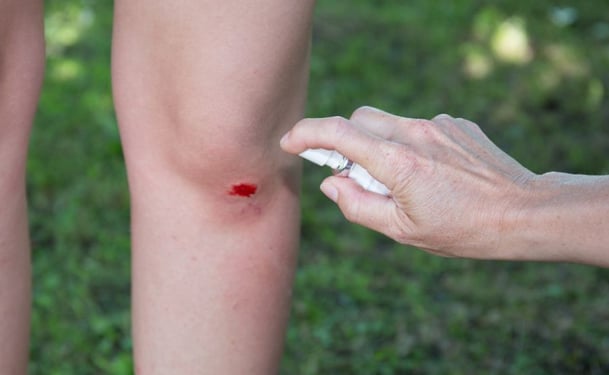Acute wounds are those that are new and in the first phase of healing. Acute wounds are characterized by skin layers that have been punctured or broken through by an external force or object. Any acute wound can progress to a chronic wound if it does not heal within the expected time frame or as a result of poor blood supply, oxygen, nutrients or hygiene. Acute wounds should be properly treated to avoid infection, inflammation or constant pressure.
Causes, Types and Symptoms of Acute Wounds
Acute wounds are categorized based on causes (lacerations, abrasions, punctures, incisions, gunshots and burns), and type according to size and depth (superficial or deep). Acute wounds can include:
- Abrasion wounds: These are caused by friction with other surfaces or objects that scrape off the top layers of skin (as can occur after falling down while running). Abrasions are shallow and usually irregular in shape, with some pain and little to no bleeding.
- Laceration wounds: These are tear-like wounds deeper than abrasions, resulting from a blunt trauma or blow from objects, collisions or accidents. The skin is usually torn irregularly and there is more pain and bleeding than seen in abrasions.
- Puncture wounds: These are small rounded wounds that result from penetrating objects such as needles or nails. The wound is typically the same size and shape as the causative object. Bleeding and pain are minor and subside shortly after removing the object.
- Incision wounds: These are clean cuts that result from sharp objects like knives, scissors and scalpels. Incisions are linear with regular edges, and can be superficial (limited to the uppermost skin layers) or deep (reaching the muscles and underlying organs). Incision wounds are very painful and can be life-threatening, especially if they involve a vital organ (like the heart or lungs) or major blood vessels.
- Gunshot wounds: These are caused by firearms; with regular, rounded edges smaller than the bullet at point of entrance. The wound may have burn marks or soot on the edges and surrounding tissue, depending on the distance of the gun from the skin when it was fired. If the bullet goes all the way through the body, the exit wound will be irregular in shape and larger than the entrance wound, with more bleeding. Bullets move in a straight line except when they hit a bone; in which case they can break through and shatter the bone, or be deflected in another direction. Apart from the risk of hitting vital organs or major blood vessels, the fast spiraling movement of the bullet can cause serious damage to the tissue it passes through.
- Burn wounds are divided into the following types:
- First degree burns: In which the burns are limited to the superficial layers of skin and present with pain, redness and hotness of the burned area
- Second degree burns: Which involve the deeper layers of skin, but still don’t reach the underlying connective tissue, presenting with pain, redness and blistering (small fluid filled sacs on skin)
- Third degree burns: Involving all of layers of skin and reaching down to the underlying connective tissue and organs. These burns are painless and usually appear whitish or are charred black.
Complications
Acute wounds can be complicated by:
- Infections: Whether due to contamination or poor hygiene, an infected wound will have a bad odor, pus or grayish drainage, and is typically accompanied by fever.
- Inflammation: The wound area becomes hot, red, swollen and painful.
- Loss of function: Either because of the pain or the damage caused by the wound to the affected limb or area, the loss of function can be temporary or permanent.
- Progression: In cases of delayed healing or poor wound care; acute wounds can develop to chronic wounds.
- Scarring: Many acute wounds will leave a scar after healing, and some will even cause a deformity of the affected area.
Treatment Options for Acute Wounds
In general, the treatment of acute wounds involves two steps:
- Wound cleaning: Acute wounds should be cleaned with warm water and soap before flushing it with a sterile solution to remove any bacteria or contaminated material. Surgical debridement of the wound may be necessary to remove the dead tissue and any foreign material (clothes, dirt, glass, bullets, metals or others). Proper wound cleaning reduces the risk of infection and promotes the healing process by providing healthy new tissue with a clean environment.
- Wound closure: Once cleaned, wounds should be closed with stitches, staples, skin adhesive bands, and dressing with a sterile bandage – with or without topical antibiotic ointment - or with skin grafting (covering the wound area with healthy skin taken from other parts of the body). Wound closure is necessary to bring the separated tissue together and cover the exposed tissue to reduce the risk of infection and promote healing. However, in cases of infected surgical wounds, the wound will be left open after surgery until the infection resolves. In these cases, closure of an infected wound will lead to more complications and failure of healing.
In some cases, a tetanus shot, systemic antibiotics, and anti-inflammatory or analgesic medications are given as a prophylactic measures to prevent any complications, and to help improve the quality of patients’ lives while the wound heals.


